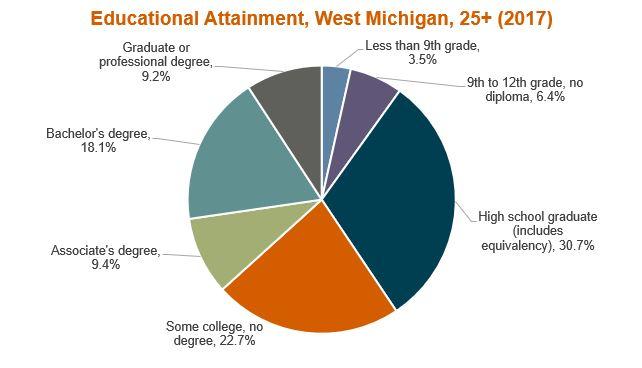Every year the U.S. Census Bureau releases several datasets that originate from the American Community Survey (ACS). Although a majority of Americans think of “the census” as the count of American citizens every decade, there’s actually much more to it. The American Community Survey continually collects a variety of social and economic information pertaining to everyone who resides in the U.S — regardless of citizenship status — and annually releases estimates for varying levels of geography.
Every Fall the 1-year ACS estimates are released for large areas with populations over 65,000. In December, the 5-year ACS estimates are released for all levels of geography, irrespective of population size, which averages estimates over a 5-year period. This allows organizations and localities to analyze information about geographies down to the ZIP code, Census tract, block group, and even individual block level.
Considering that Talent 2025 is composed of 13 counties (9 of which have population sizes below 65,000), we primarily rely on 5-year estimates to analyze our region in the aggregate. With the release of the 2013-2017 ACS estimates, we can now track progress throughout our region for a few key indicators.
Educational Attainment
Behind all of the work of Talent 2025 lies Goal 2025, which is our regional vision to have 64 percent of adults in West Michigan possess some form of education beyond a high school diploma.

New ACS data illustrates that the region continues to make progress toward our goal. In 2017, 59.4 percent of adults in West Michigan possessed some education beyond a high school diploma, with 27.2 percent of the population holding a Bachelor’s degree or above. Additionally, only 9.9 percent of adults in the region have less than a high school diploma or equivalent, which is 1.4 percentage points lower than in 2012. We are moving in the right direction.
Labor Force Participation Rate
The labor force participation rate for working-age adults (25-54) serves as another indicator that we monitor when new data is available. You can read more about why we use this statistic here on one of our past blog posts.
As with the rest of the country, West Michigan has experienced a slow recovery since the turn of the century with respect to the labor force participation rate of working-age adults, and that trend continues in the new data. Overall, 82.4 percent of working-age adults in our region were either working or looking for work in 2017, an increase of 0.4 percent from last year’s rate. This is half a percentage point lower than the rate observed in 2012, with over 7,300 more individuals being “not in the labor force” in 2017 than in 2012.
Nationally, West Michigan would rank 36th in this indicator when compared to 175 Combined Statistical Areas across the country — lagging a top-20 ranking by nearly 2 percentage points. If West Michigan’s working-age labor force participation rate could bridge this gap, over 11,000 additional workers would enter the labor force.
Commuting to Work
In order to illustrate the wealth of indicators available in the American Community Survey, we picked commuting to work as our final topic for this blog. By age group, we can view the method of transportation individuals utilized to get to work every day in our region, from driving alone and carpooling to public transportation, biking, and walking.
Unsurprisingly, the vast majority of the West Michigan labor force drove themselves to work, with 82.1 percent of workers 16 and older commuting to work in a car, truck, or van by themselves. While driving alone was the most popular means of commuting irrespective of age, there were large discrepancies across age brackets. West Michigan workers between the ages of 60 and 64 were the most prone to commuting alone via automobile, with 86.7 percent of the respective population, while those between the ages of 16 and 19 were the least likely to drive alone, at 69.8 percent. The second-most popular means of commuting in 2017 was to carpool, with 9.4 percent of the 16 and over population engaging in ridesharing. Carpooling was the most popular among the 16 to 19 age group, at 14.3 percent, and least utilized by those within the 65 and over age group, at 5.1 percent.
Future Data Topics
Have you been enjoying these “Data Points” blogs and are interested in other data? Let us know what topics you’d like to know more about on our Twitter @WMTalent2025! We’d like to crunch some numbers that you’re interested in!


